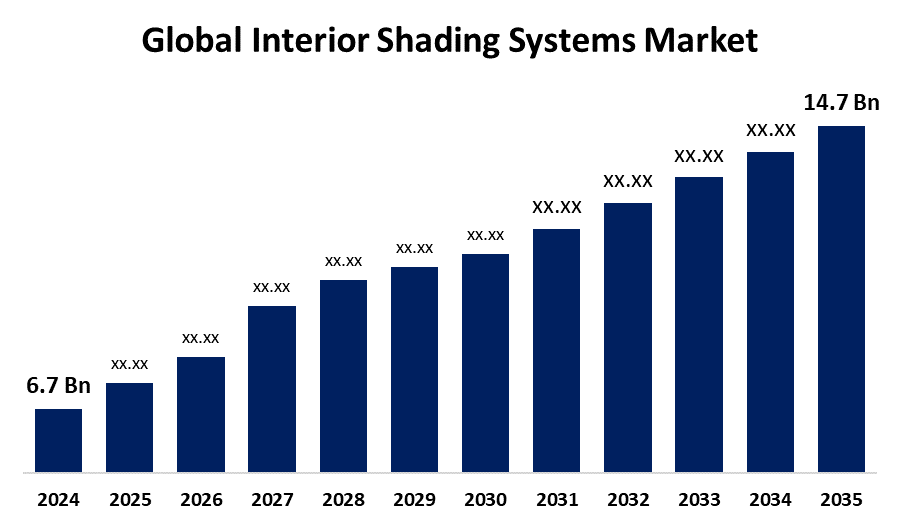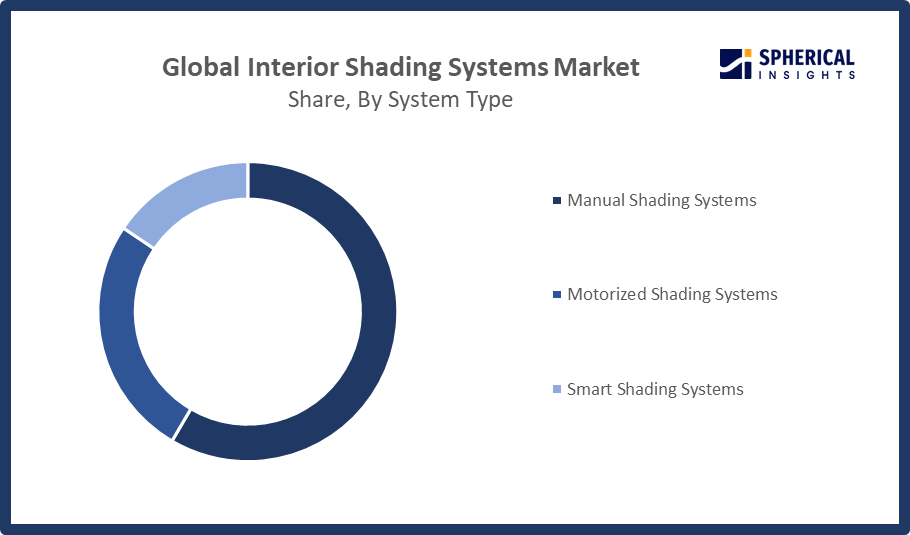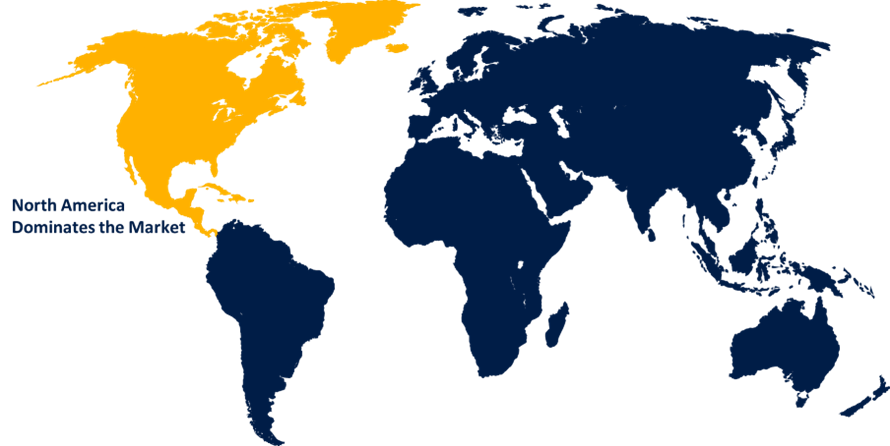Global Interior Shading Systems Market Size, Share, and COVID-19 Impact Analysis, By System Type (Manual Shading Systems, Motorized Shading Systems, and Smart Shading Systems), By Application (Residential, Commercial, and Industrial), and By Region (North America, Europe, Asia-Pacific, Latin America, Middle East, and Africa), Analysis and Forecast 2025 - 2035
Industry: Construction & ManufacturingGlobal Interior Shading Systems Market Insights Forecasts to 2035
- The Global Interior Shading Systems Market Size Was Estimated at USD 6.7 Billion in 2024
- The Market Size is Expected to Grow at a CAGR of around 7.27% from 2025 to 2035
- The Worldwide Interior Shading Systems Market Size is Expected to Reach USD 14.5 Billion by 2035
- Asia Pacific is expected to grow the fastest during the forecast period.

Get more details on this report -
According to a research report published by Spherical Insights and Consulting, The Global Interior Shading Systems Market Size was worth around USD 6.7 Billion in 2024 and is predicted to grow to around USD 14.5 Billion by 2035 with a compound annual growth rate (CAGR) of 7.27% from 2025 to 2035. The growing focus on energy efficiency and the ensuing need for efficient shading solutions to regulate indoor temperatures and lower energy consumption are the main development factors propelling this market.
Market Overview
The global interior shading systems market involves products and technologies designed to control natural light, enhance energy efficiency, improve indoor comfort, and provide aesthetic appeal in residential, commercial, and industrial spaces. The market for interior shading systems is expanding rapidly worldwide due to growing awareness of energy conservation and the benefits of shading solutions for lowering expenses and energy consumption. Adoption is also being accelerated by growing worries about climate change and government incentives supporting green building methods. Motorised and automated shading systems may now be seamlessly integrated due to advancements in smart home technologies, which improve convenience and energy efficiency. The need for shading solutions in homes and businesses is also being fuelled by rising building costs and rapid urbanisation, particularly in emerging nations. Additionally, buyers who are concerned about design are drawn to products with aesthetic appeal and customization choices, such as a variety of materials, styles, and colours.
The increased demand for connected and sustainable living spaces is reflected in the growing popularity of solar shades and automated blinds. These developments are crucial parts of contemporary, energy-efficient, and visually pleasing interiors because they provide better light management, comfort, and remote operation. Growing urbanisation, rising energy costs, and growing consumer concern for energy efficiency are the main factors propelling the market for indoor shading systems. The need for energy-efficient interior solutions is increasing as home power prices rise by 1.2% a year. By 2050, about 68% of the world's population is expected to reside in cities, which greatly increases the need for creative and beautiful shading solutions.
Report Coverage
This research report categorizes the interior shading systems market based on various segments and regions, forecasts revenue growth, and analyzes trends in each submarket. The report analyses the key growth drivers, opportunities, and challenges influencing the interior shading systems market. Recent market developments and competitive strategies such as expansion, type launch, development, partnership, merger, and acquisition, have been included to draw the competitive landscape in the market. The report strategically identifies and profiles the key market players and analyses their core competencies in each sub-segment of the interior shading systems market.
Driving Factors
The market for indoor shading systems is expanding as a result of urbanization, technology breakthroughs, and greater energy efficiency consciousness. Energy efficiency and convenience are improved by advancements in motorized and smart shading systems. Demand is also fuelled by growing construction activities and strict environmental laws. Growing disposable incomes stimulate spending on high-end, adaptable, and environmentally responsible shade options. Shading systems are becoming more common in contemporary residential and commercial settings because they improve energy management, sustainability, and aesthetic appeal when combined with smart home automation.
Restraining Factors
The market for indoor shading systems is subject to various limitations that may prevent it from growing further. The high price of sophisticated shading systems, especially those with smart technology, is one of the main obstacles. The market is still dominated by traditional blinds and curtains, and customers might not be completely aware of the advantages that cutting-edge interior shading systems provide. This ignorance may restrict market penetration, especially in developing nations where energy efficiency education programs are still in their infancy.
Market Segmentation
The Interior Shading Systems market share is classified into system type and application.
- The manual shading systems segment dominated the market in 2024, approximately 58% and is projected to grow at a substantial CAGR during the forecast period.
Based on the system type, the interior shading systems market is divided into manual shading systems, motorized shading systems, and smart shading systems. Among these, the manual shading systems segment dominated the market in 2024 and is projected to grow at a substantial CAGR during the forecast period. Manual shading systems are easy to use and reasonably priced; they have long been a favourite. These systems include manually adjustable curtains, blinds, and shades that are controlled by cables or rods. The use of manual shading solutions is common in residential and some business settings where regular modifications are not necessary. They are a more affordable alternative to motorised systems, which appeals to consumers on a tight budget.

Get more details on this report -
- The residential segment accounted for the largest share in 2024, approximately 62% and is anticipated to grow at a significant CAGR during the forecast period.
Based on the application, the interior shading systems market is divided into residential, commercial, and industrial. Among these, the residential segment accounted for the largest share in 2024 and is anticipated to grow at a significant CAGR during the forecast period. The growing use of shade solutions in homes for energy efficiency, privacy, and aesthetic enhancement has propelled the residential sector to control a sizable portion of the market. Both manual and motorized shading systems are becoming more popular among homeowners who want to save energy expenses and create comfortable living spaces. The need for integrated shading systems with remote control is being further fuelled by the expanding smart home trend.
Regional Segment Analysis of the Interior Shading Systems Market
- North America (U.S., Canada, Mexico)
- Europe (Germany, France, U.K., Italy, Spain, Rest of Europe)
- Asia-Pacific (China, Japan, India, Rest of APAC)
- South America (Brazil and the Rest of South America)
- The Middle East and Africa (UAE, South Africa, Rest of MEA)
North America is anticipated to hold the largest share with approximately 35% of the Interior Shading Systems market over the predicted timeframe.

Get more details on this report -
North America is anticipated to hold the largest share of the interior shading systems market over the predicted timeframe. The market is dominated by North America because of the rising need for smart home integration and energy-efficient construction solutions. The use of sophisticated interior shading systems is also fuelled by growing sustainability awareness and government incentives for green buildings. The market for interior shading systems is anticipated to be dominated by North America due to the region's strict energy efficiency laws and high rates of adoption of cutting-edge home automation technology. Leading markets in this area are the US and Canada, where customers are choosing smart shading solutions more and more to improve their living spaces and save energy. The market's expansion in North America is also aided by the existence of significant producers and the accessibility of a large variety of goods.
Asia Pacific is expected to grow the fastest market share with approximately 28% at a rapid CAGR in the interior shading systems market during the forecast period. The fastest-growing region is Asia Pacific, driven by rising disposable incomes, rapid urbanisation, and the development of residential and commercial infrastructure. Growing awareness of smart technology and energy conservation in nations like China, India, and Japan propels market expansion. Rapid urbanisation, rising disposable incomes, and increased energy conservation consciousness are expected to propel the interior shading systems market's expansion in the Asia Pacific region. Significant construction is taking place in nations like China, India, and Japan, which is expected to increase demand for shading systems. Further driving the market's expansion are the growing middle class and the growing adoption of smart home technology.
Europe is expected to grow at a rapid CAGR in the interior shading systems market during the forecast period. With nations like Germany, the United Kingdom, and France setting the standard, Europe is another significant market for interior shading systems. The demand for shade solutions is being driven by the region's emphasis on sustainability and energy efficiency, which is bolstered by government rules and incentives. Customers in the European market are looking for shading products that blend practicality and style, and this market is known for its high degree of customization and creativity.
Competitive Analysis:
The report offers the appropriate analysis of the key organizations/companies involved within the interior shading systems market, along with a comparative evaluation primarily based on their type of offering, business overviews, geographic presence, enterprise strategies, segment market share, and SWOT analysis. The report also provides an elaborative analysis focusing on the current news and developments of the companies, which includes type development, innovations, joint ventures, partnerships, mergers & acquisitions, strategic alliances, and others. This allows for the evaluation of the overall competition within the market.
List of Key Companies
- Hunter Douglas
- Lutron Electronics
- MechoShade Systems
- Legrand
- Somfy
- Draper Inc.
- Warema Renkhoff SE
- Rainier Industries
- QMotion
- Insolroll Window Shading Systems
- Bali Blinds, LLC
- Saint-Gobain S.A.
- 3 Day Blinds
- Comfortex Window Fashions
- Others
Key Target Audience
- Market Players
- Investors
- End-users
- Government Authorities
- Consulting and Research Firm
- Venture capitalists
- Value-Added Resellers (VARs)
Recent Development
- In July 2025, Allesin (US) launched its Prestige Motorized Roller Shades featuring no-drill installation, voice/app control (Alexa/Google via Tuya/Smart Life), cordless design, low-noise motor and custom sizing.
- In June 2025, Coulisse debuted its "Absolute Silence" motorised shade concept at R+T Asia 2025. This concept won an award for quiet motorisation and acoustic comfort.
Market Segment
This study forecasts revenue at global, regional, and country levels from 2020 to 2035. Spherical Insights has segmented the interior shading systems market based on the below-mentioned segments:
Global Interior Shading Systems Market, By System Type
- Manual Shading Systems
- Motorized Shading Systems
- Smart Shading Systems
Global Interior Shading Systems Market, By Application
- Residential
- Commercial
- Industrial
Global Interior Shading Systems Market, By Regional Analysis
- North America
- US
- Canada
- Mexico
- Europe
- Germany
- UK
- France
- Italy
- Spain
- Russia
- Rest of Europe
- Asia Pacific
- China
- Japan
- India
- South Korea
- Australia
- Rest of Asia Pacific
- South America
- Brazil
- Argentina
- Rest of South America
- Middle East & Africa
- UAE
- Saudi Arabia
- Qatar
- South Africa
- Rest of the Middle East & Africa
Frequently Asked Questions (FAQ)
-
1. What is the CAGR of the Interior Shading Systems market over the forecast period?The global Interior Shading Systems market is projected to expand at a CAGR of 7.27% during the forecast period.
-
2. What is the market size of the Interior Shading Systems market?The global Interior Shading Systems market size is expected to grow from USD 6.7 Billion in 2024 to USD 14.5 Billion by 2035, at a CAGR of 7.27% during the forecast period 2025-2035.
-
3. Which region holds the largest share of the Interior Shading Systems market?North America is anticipated to hold the largest share of the Interior Shading Systems market over the predicted timeframe.
-
4. Who are the top 10 companies operating in the global Interior Shading Systems market?Hunter Douglas, Lutron Electronics, MechoShade Systems, Legrand, Somfy, Draper Inc., Warema Renkhoff SE, Rainier Industries, QMotion, and Insolroll Window Shading Systems.
-
5. What factors are driving the growth of the Interior Shading Systems market?Rising energy efficiency awareness, growing urbanization, technological developments in smart and automated shading, growing construction activities, and supportive government regulations encouraging sustainable and energy-efficient building practices across the residential, commercial, and industrial sectors globally are all factors driving the growth of the interior shading systems market.
-
6. What are the market trends in the Interior Shading Systems market?Growing use of motorised and smart shading solutions, integration with home automation systems, use of eco-friendly materials, aesthetic customization options, and the need for energy-efficient designs in contemporary residential and commercial spaces are some of the major trends in the interior shading systems market.
-
7. What are the main challenges restricting wider adoption of the Interior Shading Systems market?Key obstacles preventing interior shading systems from being widely used worldwide include high installation and maintenance costs, low awareness in developing nations, and incompatibilities with existing building structures.
Need help to buy this report?